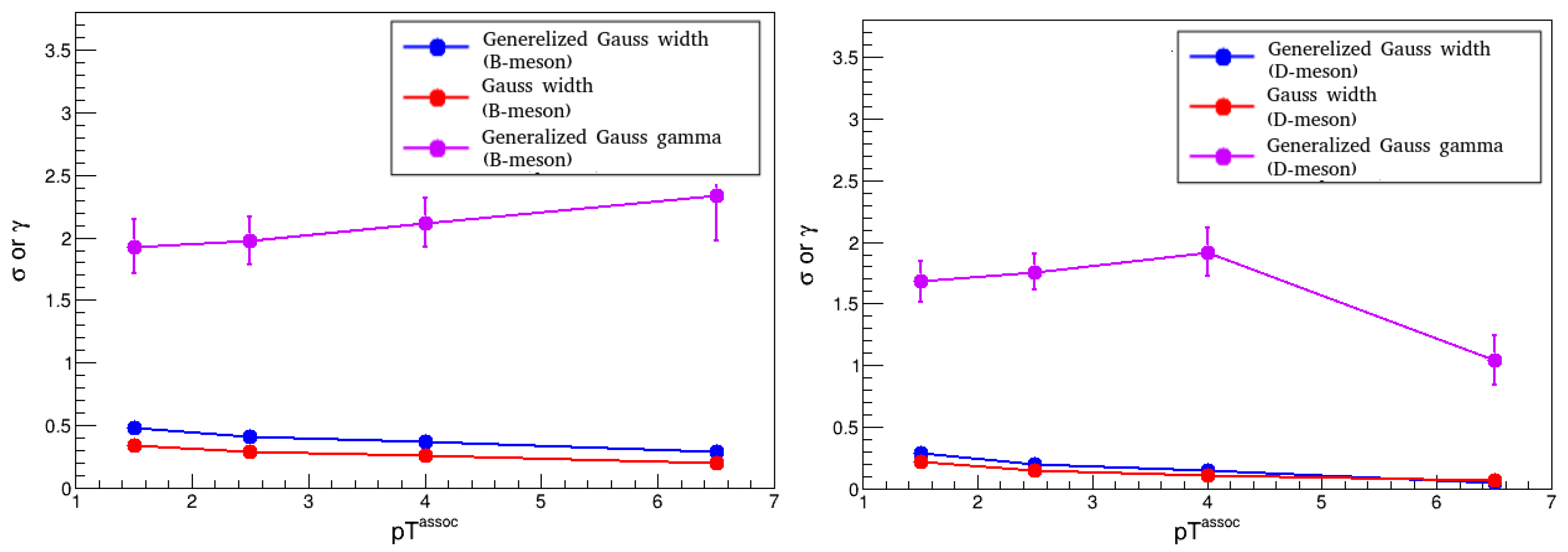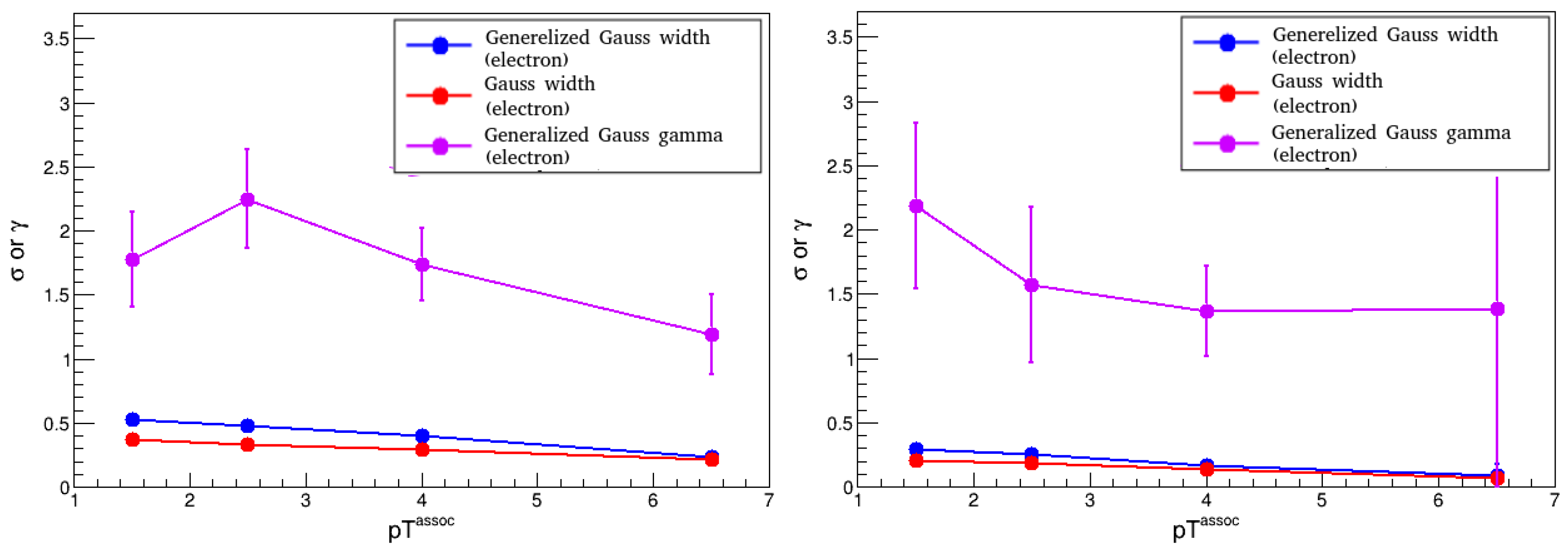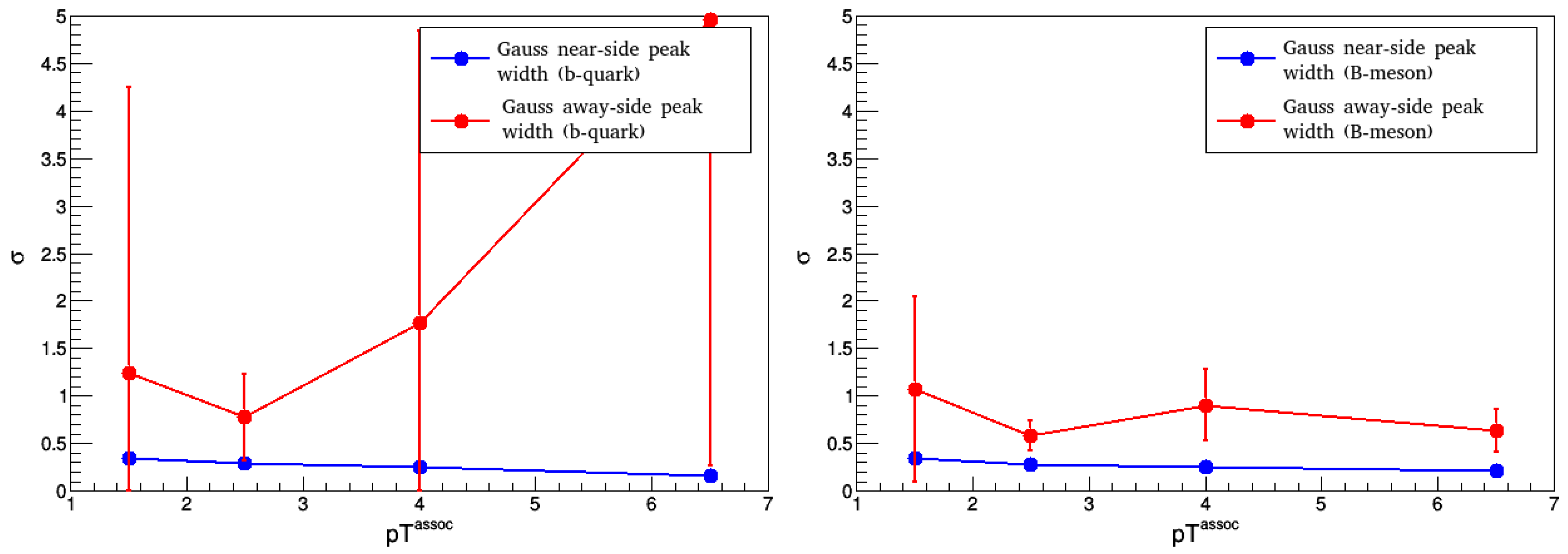1. Introduction
Quark-gluon plasma (QGP) is a state of matter which exists at extremely high temperatures and densities, where quarks are no longer confined to hadrons [
1]. Initially, the Universe was filled with this hot and dense matter. Quark-gluon plasma can be recreated in high-energy heavy-ion collisions at large accelerator rings such as the LHC.
The angular correlation data of the STAR experiment [
2] shows a strong suppression of the away-side correlation peak in central Au+Au collisions, while no such effect can be observed in p+p collisions. This indicates a strong quenching of jets that traverse the QGP. In the case of d+Au collision, we do not experience jet-suppression even though there is cold hadronic nuclear matter present. It was among the first convincing shreds of evidence of hot and dense strongly interacting nuclear matter in the final state. The interaction of partons with quark–gluon plasma is often studied by full jet reconstruction. However, in heavy-ion collisions, high background from the underlying event makes it difficult to reconstruct jets below a certain momentum. Measuring the angular correlation of particles is a technique that solves this problem. Comparison of angular correlations in small and large collision systems reveals information of jet modification by the strongly interacting medium.
Heavy-flavor (charm and beauty) quarks are an excellent tool to study heavy-ion collisions. Most of them are created in the initial stages of the reaction, and their long lifetime ensures that they interact both with the hot and dense medium as well as with the cold hadronic matter before they decay. Identifying characteristic correlation images of heavy and light quarks can help understand flavor-dependent fragmentation. Furthermore, finding these characteristic shapes can be used as an alternative method to pin down feed-down of beauty hadrons into charm without the need to find the secondary vertex. We carried out studies with the PYTHIA 8.1 Monte Carlo event generator [
3] to compare the near-side and away-side correlation peaks associated with hadrons from different heavy quarks from a given
. The following simulation results serve as a case study that the techniques we developed can be successfully applied in today’s large experiments such as ALICE at the LHC to aid and interpret heavy-flavor correlation measurements.
2. Analysis Method
We used the PYTHIA 8.1 Monte Carlo event generator [
3] to simulate hard QCD events using the default Monash 2013 [
4] settings for LHC p + p data. Five million p − p collision events were simulated at a time, at the center-of-mass energy of
TeV. The phase space has been reduced so that the leading hard process has at least 5 GeV/c momentum. Heavy flavor scale settings were used similarly to recent STAR analyses, e.g., that in [
5]. For beauty and charm simulations, only the two-to-two processes were enabled (
and
, as well as
and
, respectively), while light hadron correlations were simulated by allowing all hard quantum color dynamics processes.
The variables we use to describe particle kinematics are the three-momentum (), the azimuth angle () and the pseudorapidity (, where is the transverse momentum).
To examine the correlation of particles, we followed a technique similar to [
6]. We selected a trigger particle from a given momentum (
) range, and associated particles from a lower momentum (
) window to examine all other particles from the same event. Then we calculated the differences in the azimuth angles as well as the pseudorapidities of the trigger and associated particles within each event. The plane (
) can be divided into two parts along
: near-side and away-side peak region. We defined near-side as the range from
to
, and the away-side as the range from
/2 to 3
/2. Near-side correlations give information about the structure of jets since, after background subtraction, most trigger and associated particles come from the same jet. Differences between correlations of beauty, charm and light flavor provide valuable information about flavor-dependent jet fragmentation. Away-side correlation is mostly from back-to-back jet pairs and it is sensitive to the underlying hard processes.
We examined the width of fitted functions in the GeV/c trigger particle transverse momentum range, and in different associated particle transverse momentum () ranges ( GeV/c, GeV/c, GeV/c and GeV/c). In the latter case we ensured that > .
Correlation analyses usually use the mixed-event technique to correct for the finite size of the detector in
[
6]. However, at mid-rapidity it is sufficient to assume a uniform track distribution and therefore we apply a reweighting of events with a “tent-shaped” function
where
is the maximal acceptance in which tracks were recorded. In the analysis, we only used the |
|< 1.6 range.
Processes that fulfilled the conditions of the central limit theorem yield Gaussian-shaped correlation peaks. In case of weakly decaying resonances corresponding to secondary vertices that can be displaced with several millimeters, however, the Gaussian shape is not necessarily adequate. Therefore we also apply a Generalized Gaussian fit on the near- and away-side correlation peaks. Gaussian functions of the different projections are
and the generalized Gaussian functions of the different projections are
where
N is the normalization factor,
is the width of the peak in the direction of
, and
is the width of the peak in the direction of
.
The generalized Gaussian function has an extra parameter compared to the Gaussian. If = 1, then the generalized Gaussian function is an exponential function. If = 2, it was reduced to a regular Gaussian function. If was greater than two then the top of the function was flattened.










